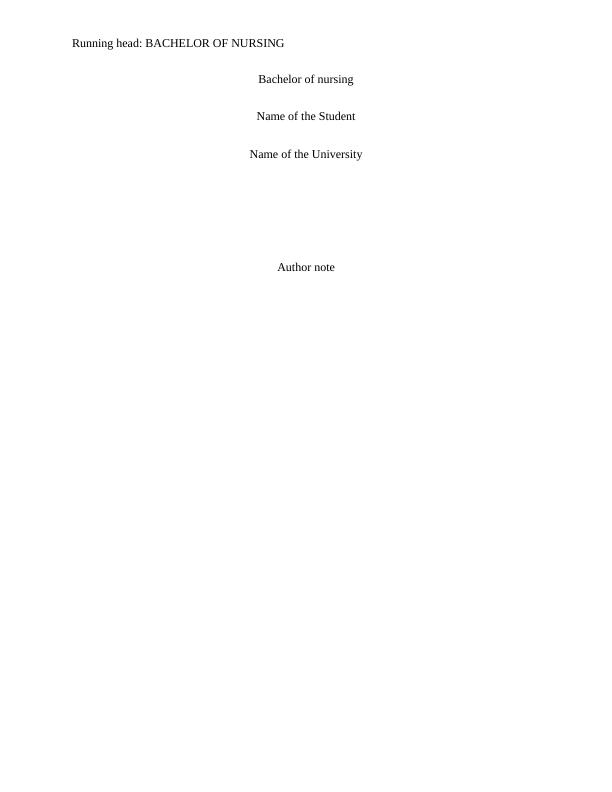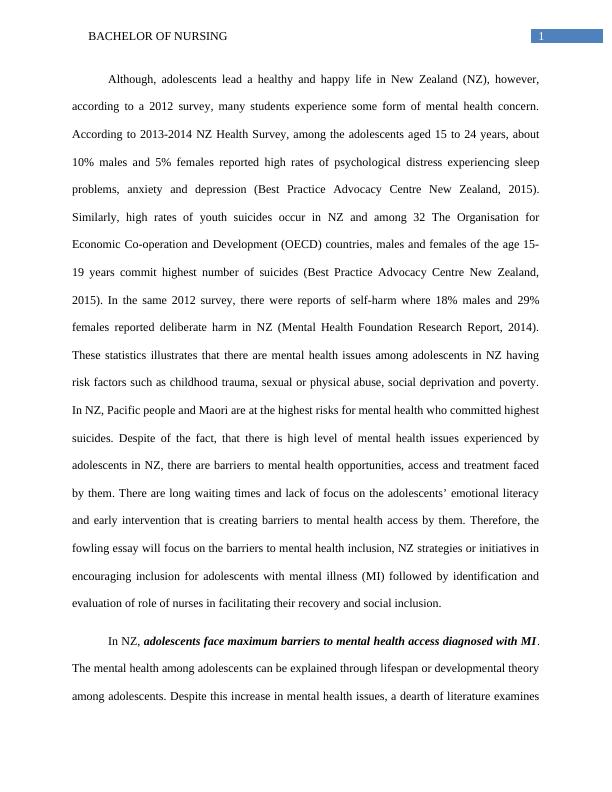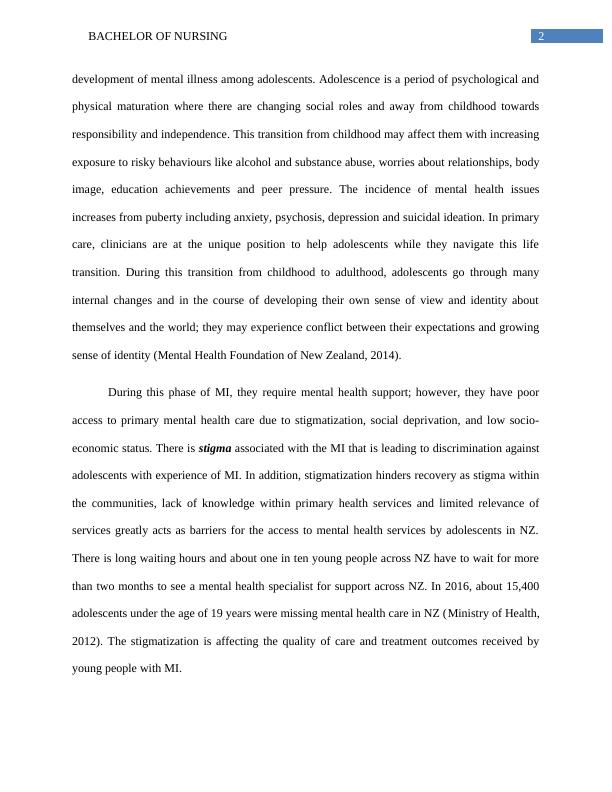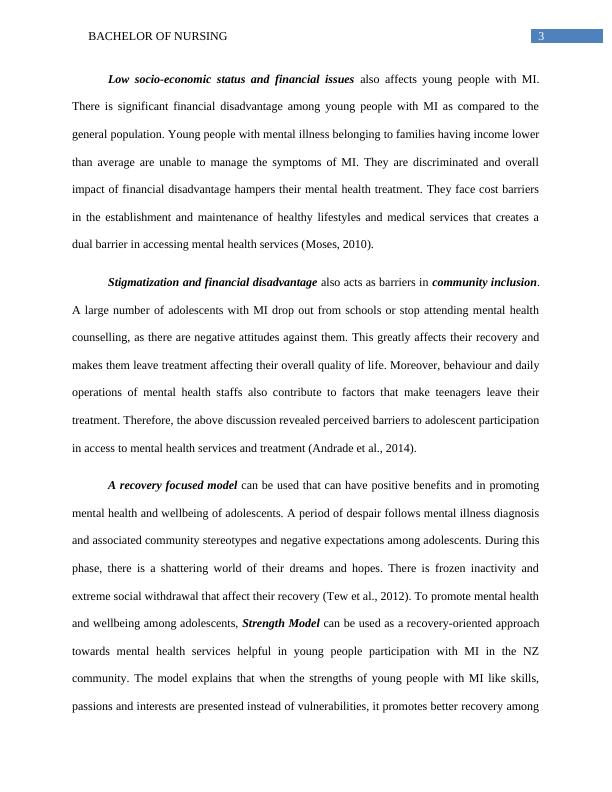Barriers to Mental Health Inclusion for Adolescents in New Zealand
Rubric for BN606 assessment with different categories and scores
13 Pages3605 Words205 Views
Added on 2023-06-15
About This Document
This essay discusses the barriers to mental health inclusion for adolescents in New Zealand, the strategies and initiatives taken by the country to encourage inclusion, and the role of nurses in facilitating recovery and social inclusion.
Barriers to Mental Health Inclusion for Adolescents in New Zealand
Rubric for BN606 assessment with different categories and scores
Added on 2023-06-15
ShareRelated Documents
Running head: BACHELOR OF NURSING
Bachelor of nursing
Name of the Student
Name of the University
Author note
Bachelor of nursing
Name of the Student
Name of the University
Author note

1BACHELOR OF NURSING
Although, adolescents lead a healthy and happy life in New Zealand (NZ), however,
according to a 2012 survey, many students experience some form of mental health concern.
According to 2013-2014 NZ Health Survey, among the adolescents aged 15 to 24 years, about
10% males and 5% females reported high rates of psychological distress experiencing sleep
problems, anxiety and depression (Best Practice Advocacy Centre New Zealand, 2015).
Similarly, high rates of youth suicides occur in NZ and among 32 The Organisation for
Economic Co-operation and Development (OECD) countries, males and females of the age 15-
19 years commit highest number of suicides (Best Practice Advocacy Centre New Zealand,
2015). In the same 2012 survey, there were reports of self-harm where 18% males and 29%
females reported deliberate harm in NZ (Mental Health Foundation Research Report, 2014).
These statistics illustrates that there are mental health issues among adolescents in NZ having
risk factors such as childhood trauma, sexual or physical abuse, social deprivation and poverty.
In NZ, Pacific people and Maori are at the highest risks for mental health who committed highest
suicides. Despite of the fact, that there is high level of mental health issues experienced by
adolescents in NZ, there are barriers to mental health opportunities, access and treatment faced
by them. There are long waiting times and lack of focus on the adolescents’ emotional literacy
and early intervention that is creating barriers to mental health access by them. Therefore, the
fowling essay will focus on the barriers to mental health inclusion, NZ strategies or initiatives in
encouraging inclusion for adolescents with mental illness (MI) followed by identification and
evaluation of role of nurses in facilitating their recovery and social inclusion.
In NZ, adolescents face maximum barriers to mental health access diagnosed with MI.
The mental health among adolescents can be explained through lifespan or developmental theory
among adolescents. Despite this increase in mental health issues, a dearth of literature examines
Although, adolescents lead a healthy and happy life in New Zealand (NZ), however,
according to a 2012 survey, many students experience some form of mental health concern.
According to 2013-2014 NZ Health Survey, among the adolescents aged 15 to 24 years, about
10% males and 5% females reported high rates of psychological distress experiencing sleep
problems, anxiety and depression (Best Practice Advocacy Centre New Zealand, 2015).
Similarly, high rates of youth suicides occur in NZ and among 32 The Organisation for
Economic Co-operation and Development (OECD) countries, males and females of the age 15-
19 years commit highest number of suicides (Best Practice Advocacy Centre New Zealand,
2015). In the same 2012 survey, there were reports of self-harm where 18% males and 29%
females reported deliberate harm in NZ (Mental Health Foundation Research Report, 2014).
These statistics illustrates that there are mental health issues among adolescents in NZ having
risk factors such as childhood trauma, sexual or physical abuse, social deprivation and poverty.
In NZ, Pacific people and Maori are at the highest risks for mental health who committed highest
suicides. Despite of the fact, that there is high level of mental health issues experienced by
adolescents in NZ, there are barriers to mental health opportunities, access and treatment faced
by them. There are long waiting times and lack of focus on the adolescents’ emotional literacy
and early intervention that is creating barriers to mental health access by them. Therefore, the
fowling essay will focus on the barriers to mental health inclusion, NZ strategies or initiatives in
encouraging inclusion for adolescents with mental illness (MI) followed by identification and
evaluation of role of nurses in facilitating their recovery and social inclusion.
In NZ, adolescents face maximum barriers to mental health access diagnosed with MI.
The mental health among adolescents can be explained through lifespan or developmental theory
among adolescents. Despite this increase in mental health issues, a dearth of literature examines

2BACHELOR OF NURSING
development of mental illness among adolescents. Adolescence is a period of psychological and
physical maturation where there are changing social roles and away from childhood towards
responsibility and independence. This transition from childhood may affect them with increasing
exposure to risky behaviours like alcohol and substance abuse, worries about relationships, body
image, education achievements and peer pressure. The incidence of mental health issues
increases from puberty including anxiety, psychosis, depression and suicidal ideation. In primary
care, clinicians are at the unique position to help adolescents while they navigate this life
transition. During this transition from childhood to adulthood, adolescents go through many
internal changes and in the course of developing their own sense of view and identity about
themselves and the world; they may experience conflict between their expectations and growing
sense of identity (Mental Health Foundation of New Zealand, 2014).
During this phase of MI, they require mental health support; however, they have poor
access to primary mental health care due to stigmatization, social deprivation, and low socio-
economic status. There is stigma associated with the MI that is leading to discrimination against
adolescents with experience of MI. In addition, stigmatization hinders recovery as stigma within
the communities, lack of knowledge within primary health services and limited relevance of
services greatly acts as barriers for the access to mental health services by adolescents in NZ.
There is long waiting hours and about one in ten young people across NZ have to wait for more
than two months to see a mental health specialist for support across NZ. In 2016, about 15,400
adolescents under the age of 19 years were missing mental health care in NZ (Ministry of Health,
2012). The stigmatization is affecting the quality of care and treatment outcomes received by
young people with MI.
development of mental illness among adolescents. Adolescence is a period of psychological and
physical maturation where there are changing social roles and away from childhood towards
responsibility and independence. This transition from childhood may affect them with increasing
exposure to risky behaviours like alcohol and substance abuse, worries about relationships, body
image, education achievements and peer pressure. The incidence of mental health issues
increases from puberty including anxiety, psychosis, depression and suicidal ideation. In primary
care, clinicians are at the unique position to help adolescents while they navigate this life
transition. During this transition from childhood to adulthood, adolescents go through many
internal changes and in the course of developing their own sense of view and identity about
themselves and the world; they may experience conflict between their expectations and growing
sense of identity (Mental Health Foundation of New Zealand, 2014).
During this phase of MI, they require mental health support; however, they have poor
access to primary mental health care due to stigmatization, social deprivation, and low socio-
economic status. There is stigma associated with the MI that is leading to discrimination against
adolescents with experience of MI. In addition, stigmatization hinders recovery as stigma within
the communities, lack of knowledge within primary health services and limited relevance of
services greatly acts as barriers for the access to mental health services by adolescents in NZ.
There is long waiting hours and about one in ten young people across NZ have to wait for more
than two months to see a mental health specialist for support across NZ. In 2016, about 15,400
adolescents under the age of 19 years were missing mental health care in NZ (Ministry of Health,
2012). The stigmatization is affecting the quality of care and treatment outcomes received by
young people with MI.

3BACHELOR OF NURSING
Low socio-economic status and financial issues also affects young people with MI.
There is significant financial disadvantage among young people with MI as compared to the
general population. Young people with mental illness belonging to families having income lower
than average are unable to manage the symptoms of MI. They are discriminated and overall
impact of financial disadvantage hampers their mental health treatment. They face cost barriers
in the establishment and maintenance of healthy lifestyles and medical services that creates a
dual barrier in accessing mental health services (Moses, 2010).
Stigmatization and financial disadvantage also acts as barriers in community inclusion.
A large number of adolescents with MI drop out from schools or stop attending mental health
counselling, as there are negative attitudes against them. This greatly affects their recovery and
makes them leave treatment affecting their overall quality of life. Moreover, behaviour and daily
operations of mental health staffs also contribute to factors that make teenagers leave their
treatment. Therefore, the above discussion revealed perceived barriers to adolescent participation
in access to mental health services and treatment (Andrade et al., 2014).
A recovery focused model can be used that can have positive benefits and in promoting
mental health and wellbeing of adolescents. A period of despair follows mental illness diagnosis
and associated community stereotypes and negative expectations among adolescents. During this
phase, there is a shattering world of their dreams and hopes. There is frozen inactivity and
extreme social withdrawal that affect their recovery (Tew et al., 2012). To promote mental health
and wellbeing among adolescents, Strength Model can be used as a recovery-oriented approach
towards mental health services helpful in young people participation with MI in the NZ
community. The model explains that when the strengths of young people with MI like skills,
passions and interests are presented instead of vulnerabilities, it promotes better recovery among
Low socio-economic status and financial issues also affects young people with MI.
There is significant financial disadvantage among young people with MI as compared to the
general population. Young people with mental illness belonging to families having income lower
than average are unable to manage the symptoms of MI. They are discriminated and overall
impact of financial disadvantage hampers their mental health treatment. They face cost barriers
in the establishment and maintenance of healthy lifestyles and medical services that creates a
dual barrier in accessing mental health services (Moses, 2010).
Stigmatization and financial disadvantage also acts as barriers in community inclusion.
A large number of adolescents with MI drop out from schools or stop attending mental health
counselling, as there are negative attitudes against them. This greatly affects their recovery and
makes them leave treatment affecting their overall quality of life. Moreover, behaviour and daily
operations of mental health staffs also contribute to factors that make teenagers leave their
treatment. Therefore, the above discussion revealed perceived barriers to adolescent participation
in access to mental health services and treatment (Andrade et al., 2014).
A recovery focused model can be used that can have positive benefits and in promoting
mental health and wellbeing of adolescents. A period of despair follows mental illness diagnosis
and associated community stereotypes and negative expectations among adolescents. During this
phase, there is a shattering world of their dreams and hopes. There is frozen inactivity and
extreme social withdrawal that affect their recovery (Tew et al., 2012). To promote mental health
and wellbeing among adolescents, Strength Model can be used as a recovery-oriented approach
towards mental health services helpful in young people participation with MI in the NZ
community. The model explains that when the strengths of young people with MI like skills,
passions and interests are presented instead of vulnerabilities, it promotes better recovery among

End of preview
Want to access all the pages? Upload your documents or become a member.
Related Documents
Opportunities and Barriers of Inclusion | Health Assignmentlg...
|18
|4075
|49
